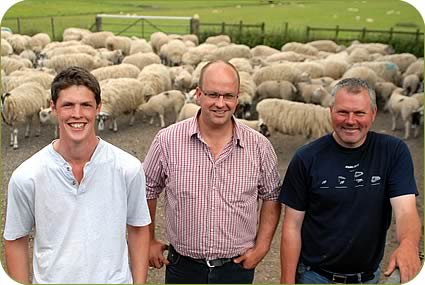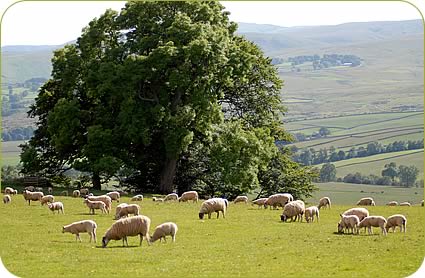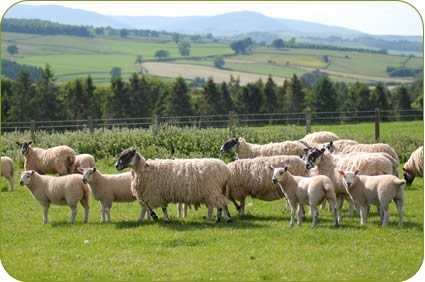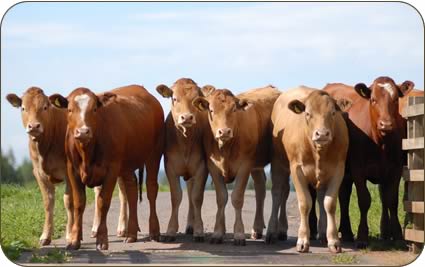Jennifer MacKenzie is an agricultural photo journalist with almost 30 year's experience. Operating from her base in Cumbria, Jennifer undertakes mainly industry-related freelance writing and photography.
Mules make a come-back
The North of England Mule has made a come-back to a Cumbrian estate, fitting
a new, extensive management system for the commercial ewe flock.
Long-standing convert to the North of England Mule, Richard Price, farm manager on the Lowther Estate, near Penrith, set about radically altering the sheep enterprise to ensure that the flock paid its way - and a return to the prolific Bluefaced Leicester-Swaledale cross ewe is at the heart of the changes.
 |
| Lowther farm manager Richard Price, centre, with shepherds Peter Horn, left, and John Harrrison |
Last autumn, 1,500 shearlings and two shear Mule ewes were bought at local auction sales at an average of £104 a head to replace half the Lleyn cross ewes which for nine years until January 2010 had been run on an organic system along with the rest of the farming enterprise.
“For the future, it’s imperative that the sheep should keep us - not us keeping the sheep,” said Richard, who was involved with the Mule at Greenlands Estate, owned by Mrs HC Pilkington, in Warwickshire for nine years and latterly as farm manager at Warwickshire College for seven years before his move to Lowther two and a half years ago.
Prior to the foot and mouth epidemic in 2001, the Lowther Estate’s ewe flock had been predominantly North of England Mules but after re-stocking the decision was taken to farm organically.
The latest Mules, which will eventually make up the entire flock at Lowther as well as a further 500 ewes at the estate’s Nord Vue farm near Armathwaite in the Eden Valley, are core to the new management regime which involves electronically tagging all ewes and lambs as well as Beltex cross Texel, Suffolk and Charollais rams to monitor individual performance as well as adapting new systems to cut down on staffing.
 |
| Mule ewes and lambs |
At Lowther, 3,500 acres are farmed in-hand, which includes 500 arable acres, and the grazing ground carries 3,500 ewes which are managed to complement the 280 Limousin cross Stabiliser and British Blue suckler cows and 180 head of red deer as well as 50 pedigree Shorthorns at Nord Vue.
“One of the main reasons we have gone back to the Mule and changed the system is so that we can grow bigger, stronger lambs that give us greater flexibility in what we produce and sell,” said Richard.
“Weight is money and if you can control that and manage it, it opens up more doors to market what we produce. Under the organic system the majority of lamb sales were deadweight. I’m a firm believer that we should be mixing sales between live and deadweight for different specifications. I don’t commit to any forward selling of lamb,” he added.
The first draft of 80 lambs sold on July 21 through Penrith Auction Mart and averaged £70.50 / head at 42 kilo liveweight.
“I personally have been buying Mules in Cumbria for the last decade and more. It’s a traditional breed for the area and many of the Lowther Estate tenant farmers are producing Mules and we value their input into the local economy. Provenance is also very important.”
 |
| Mule ewes and lambs |
The ewe flock has to run at anything from 300ft above sea level to 1,600 ft on a mixture of land and the Mule adapts perfectly to the varied conditions.
The sheep enterprise is headed by John Harrison, who joined Lowther as shepherd two years ago and whose family has bred Swaledale and Mule sheep in the Shap area for generations. Working closely with Bill McCombie, who manages the cattle, John is asisted by full time shepherd by Peter Horn. Peter has already made an impact on the flock working closely with John
Good management and quality sheep have helped reduce mortality. This season, the flock scanned at 190 per cent and were running with 182 per cent at clipping time, despite containing a lot of shearlings.
“The Mule ewes have carried and mothered the lambs well and once they are over the first month after lambing they are away. We have had very few mis-mothering problems thanks to our excellent part time lambing staff who know the system and the Mule’s mothering and milking ability, producing quality colostrum,” said Richard.
Staff numbers have been reduced although extra are hired for the indoor lambing from April 10 which gives the opportunity to rest the grazing and allow the ewes and lambs to benefit from the spring grass.
Ewes are vaccinated two to three weeks prior to lambing with Heptavac and wormed with Dectomax.
The main lambing period last for 20 days with up to 200 ewes lambing in a 24 hour period. Two people are employed for lambing during the night and three during the day
Previously the ewes were divided into three flocks and lambed outside but now lambing is inside over a concentrated period.
At tupping, the rams are loosed with all of the ewes for 10 days without raddle and these are the first ewes to be housed the following spring. A further two lots are raddled and housed at lambing time while the remainder lamb outside on lower ground
To save extra work and stress on the lamb, they are ringed before turnout which is within 24 hours of birth, as well as being scratched with Scabivax for orf and numbered.
The farm is mapped and fields colour-coded to enable ewes and lambs to be batched according to the rams used. This is a very simple system which all part time and full time staff can understand. lambs are vaccinated against coccidiosis with Vecoxan at a cost of 90p a lamb.
 |
| Limousin cross Stabiliser heifers |
They are allowed to settle with their mothers for six weeks before worming and drenching with a mineral drench, Zintec, made up after soil has been analysed. The pour-on Clik is used on the lambs to prevent maggots and blowfly. Ewes are tailed and feet are dressed.
“We had a very rough tupping time last year with the weather being very wet but the Mules tupped very well,” said Richard. “This was followed by a hard winter with snow on the ground for up to 10 weeks which resulted in us buying in good quality fodder - clamp silage at 12 ME and 36 per cent dry matter - but it was well worth it. Ewes were condition scored and fed accordingly.”
The extra fodder cost an average £2 a ewe. Concentrate is fed through a snacker in the fields from January at an average of 18kg a ewe with last winter’s cost at £190 a tonne.
“A lot of producers have been breeding from lambs by a terminal sire off the Mule. But the Mule has been bred for her female traits and she is a reliable, prolific, durable and sustainable sheep. I think a lot of people will realise this and come back to the Mule,” added Richard.
“The Swaledale breed has moved forward and breeders are focused on what the market wants from the Mule. There was concern that the Mule was starting to lose ground and producers were turning to continental breeding, but now I think people have come around and the Mule has a great future.
“If producers were really honest with their recording of such as conception rates and weight of lambs they would realise that over a sustained period that the Mule is durable and lives longer.
“It’s very easy to remember that top pen of lambs from the first draw, but profit is usually made or lost in the last 25 per cent of what we sell. If we invest in a ewe she needs to be producing for five seasons.
“Mule breeders have stuck to the system through a number of really bad autumns and had a lot of opportunities to cash in their draft ewes, but they haven’t done that. They have kept their belief in the Mule.”
Previously Lleyn and Meatlinc sires were used on the Lleyn cross ewes.The Mule ewes, says Richard, have given extra length and shape and the terminal sires - 10 per cent are Suffolk, 20 per cent Charolais and the remainder Beltex cross Texel - have improved lamb weights.
Aiming to make the most of the farm’s grazing which is now being improved in a rotational cropping system, lambs are not creep fed. Lambs are drawn at around 42kg from early July onwards.
“My aim is to create a sustainable sheep enterprise. We have learned a lot from the organic system which takes us back to old husbandry methods.
“We can grow grass without trying in Cumbria so you need a sheep that is going to convert that grass into protein and into lamb. Weight, shape and conformation are crucial and this system with the Mule produces a very marketable lamb,” added Richard.

